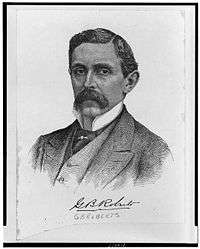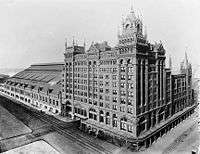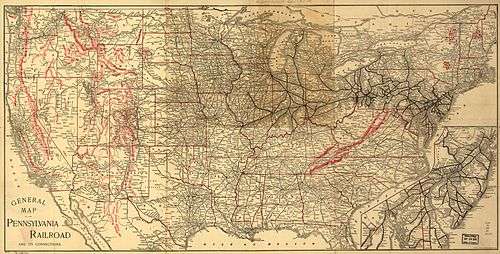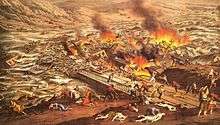George Brooke Roberts

George Brooke Roberts (January 15, 1833 – January 30, 1897) was a civil engineer and the fifth president of the Pennsylvania Railroad (1880–96).
Career
Born on Pencoyd, his family's ancestral farm in Bala Cynwyd, Pennsylvania, Roberts graduated from Rensselaer Polytechnic Institute in 1849, and taught there for two years before becoming a rodman for the Pennsylvania Railroad (PRR). From 1852 he worked for the Philadelphia & Erie Railroad, returning to the PRR in 1862 as assistant to the president, J. Edgar Thomson. Roberts oversaw the construction of bridges and other engineering work, including the Connecting Railway Bridge over Schuylkill River in Philadelphia (attributed to John A. Wilson, 1866–67) that connected PRR's southern and northern lines. He became a PRR vice-president in 1869, and succeeded Thomas A. Scott as PRR president in 1880.[1]
Broad Street Station

As PRR First Vice-President, Roberts oversaw the construction of Broad Street Station, a seminal event in Philadelphia history. Before this, PRR locomotives did not cross the Schuylkill River, but deposited passengers at West Philadelphia Station (32nd Street) where horse-drawn streetcars brought them into Center City. Construction of a new bridge and a 10-block viaduct – the "Chinese Wall" – carried the PRR tracks two stories above street level and into the Wilson Brothers-designed station at Broad Street.[2]
With the 1871 decision to build Philadelphia City Hall, the 1876 opening of merchant John Wanamaker's department store to the east, and the 1881 opening of the PRR station to the west, the center of Philadelphia's business district rapidly moved to Broad & Market Streets. The station's location at the heart of the city made commuting via the PRR practicable, fueling massive suburban growth (especially on the Main Line). By 1886, the station saw a million passengers a month. In 1889, a freight depot was built along the "Chinese Wall" at 19th Street, so the station could be devoted just to passengers. In 1892, Roberts hired architect Frank Furness to greatly expand Broad Street Station, consolidating PRR offices in a single building and turning it into the largest passenger terminal in the world.[3]
PRR Expansion
Roberts's first major accomplishment as PRR president was the 1881 purchase of a majority stake in the Philadelphia, Wilmington & Baltimore Railroad, providing a direct PRR line from New York City (actually Jersey City, New Jersey, until 1911) to Washington, DC. Amtrak uses this same route today.
Competition between the PRR and the New York Central Railroad was fierce. William H. Vanderbilt and Andrew Carnegie began construction of the South Pennsylvania Railroad across Pennsylvania to directly compete with the PRR's Main Line. In response, Roberts bought up land on the west side of the Hudson River for the West Shore Railroad, to directly compete with the NYCR on the east side. J. P. Morgan saw this as wasteful competition and negotiated an 1885 truce between Vanderbilt and Roberts, in which each abandoned the competing line. Vanderbilt's line became the right-of-way for the Pennsylvania Turnpike, and Roberts's line for the Palisades Parkway.[4]
In 1887, the PRR introduced direct service from New York City to Chicago, Illinois. The Pennsylvania Limited made the trip in 24 hours by way of Philadelphia, Harrisburg and Pittsburgh. By 1902, an express train was introduced, the Pennsylvania Special, that cut the time to 20 hours.[5]
The 1889 Johnstown Flood occurred during Roberts's presidency. The PRR's Stone Bridge over the Conemaugh River in Johnstown acted as a dam, trapping debris that covered 30 acres (and soon caught fire). The PRR was a major participant in the rescue effort. It reopened its line to Pittsburgh within 3 days, and was the primary means by which relief workers and provisions reached the victims of the disaster. The Stone Bridge still stands today.
Legacy
Roberts greatly expanded the PRR, investing more than $50,000,000 in roadways and equipment – more than all his predecessors combined – and increasing PRR holdings to about $115,000,000 through mergers and purchases of affiliated companies.[6] By the end of his 16-year term as president, the Pennsylvania Railroad was the largest private employer in the United States and the largest business corporation in the world.[7]

Family
Roberts's ancestors had been among the founders of Pennsylvania. The first emigrant, John Roberts, bought a 1,100-acre (4.5 km2) parcel along the Schuylkill River in 1682, and built a house two years later that he named "Pencoyd". This was part of the "Welsh Barony", a 40,000-acre (160 km2) tract bought by Welsh investors from William Penn. The "Welsh Barony" made up much of the Philadelphia suburban region now known as the Main Line, named for the Main Line of Public Works, a cross-state rail-and-canal system that ran through it.
Roberts was the sixth proprietor of Pencoyd, and proud of his Welsh heritage. He chose Welsh names for some of the suburban PRR stations, including Bala and Cynwyd.
Roberts hired Frank Furness to expand the family house at Pencoyd in 1883, and in 1890 the architect designed the PRR's second Bryn Mawr Hotel (now the Baldwin School).
Theophilus Parsons Chandler, Jr. designed St. Asaph's Church, at the southern end of Roberts's farm.[8] Author Nathaniel Burt quipped: "The Church of St. Asaph, dedicated, as the saying goes, to the Glory of God and the convenience of the Roberts family."[9]
In 1868, Roberts married Sarah Brinton, who died the following year after giving birth to George Brinton Roberts. In 1874, he married Miriam Pyle Williams, and the couple had five children: Algernon Brooke Roberts, T. Williams Roberts, Elizabeth Williams Roberts (who married Percy H. Clark of the Clark banking family), Isaac Warner Roberts, and Miriam Williams Roberts (married Spencer Ervin). Miriam Roberts died in 1913.
T. Williams Roberts became the seventh proprietor of Pencoyd, removed all the Frank Furness alterations to the house, and lived there until his death in 1962. Pencoyd was sold, and demolished by developers in 1964. Office buildings and a Saks Fifth Avenue department store now occupy the City Avenue site.[10]
-
.jpg)
Connecting Railway Bridge over Schuylkill River, Philadelphia, Pennsylvania (1866–67).
-

Print of the 1889 Johnstown Flood showing the PRR Stone Bridge.
-

"Pencoyd," Bala Cynwyd, Pennsylvania (1684, demolished 1964). The 1883 section by Frank Furness is to the right.
-
Bryn Mawr Hotel (1890–91), Bryn Mawr, Pennsylvania. Now the Baldwin School.
-

Broad Street Station Trainshed (1892, demolished 1953) had a single span of 306 feet (91 m).
-

Church of St. Asaph, Bala Cynwyd, Pennsylvania (1897).
Notes
- ↑ Wilson, "George Brooke Roberts," pp. 246-60.
- ↑ Churella 2013, pp. 511–512
- ↑ Churella 2013, pp. 512–513
- ↑ William H. Shank, Vanderbilt's Folly: A History of the Pennsylvania Turnpike (1964).
- ↑ Arthur D. Dubin, Some Classic Trains (Kalmbach Publications, 1964), pp.76-95.
- ↑ David Loth, Pencoyd and the Roberts Family (1961), p. 54.
- ↑ Churella 2013, p. 507
- ↑ Joan Church Roberts, Our First One Hundred Years: The Church of Saint Asaph, Bala Cynwyd, Pennsylvania (1992)
- ↑ Nathaniel Burt, The Perennial Philadelphians (1963), p. 192.
- ↑ The First 300: The Amazing and Rich History of Lower Merion from Lower Merion Historical Society.
References
- William Bender Wilson, History of the Pennsylvania Railroad Company (1895).
- Churella, Albert J. (2013). The Pennsylvania Railroad: Volume I, Building an Empire, 1846-1917. Philadelphia: University of Pennsylvania Press. ISBN 978-0-8122-4348-2. OCLC 759594295.
External links
- January 31, 1897 New York Times obituary
- Roberts Family Papers, at Lower Merion Historical Society
- George Brooke Roberts at Find a Grave
- George Brooke Roberts (1833–1897), from Johnstown National Memorial, Pennsylvania (National Park Service).
| Preceded by Thomas A. Scott |
President of Pennsylvania Railroad 1880 – 1896 |
Succeeded by Frank Thomson |